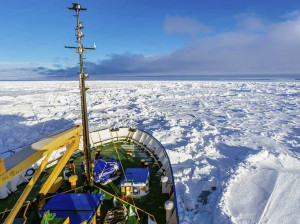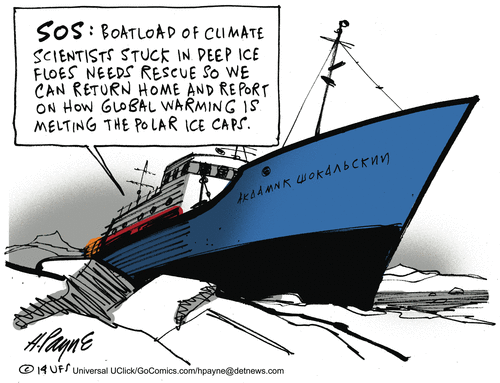redo Jump to...
print Print...
Directions
-Read the excerpt below from Mike Ciandella's post at BusinessandMedia.org.
-Read "Types of Media Bias" here (found on the website under "Resources" OR on the app under "More"). Then answer the questions.
From a post by Mike Ciandella at BusinessandMedia.org (original post date Jan. 2):
A group of climate change scientists were rescued by helicopter Jan. 2, after being stranded in the ice since Christmas morning. But the majority of the broadcast networks’ reports about the ice-locked climate researchers never mentioned climate change.

Nowhere to go: A view from the MV Akademik Shokalskiy.
The Russian ship, Akademic Shokalskiy, was stranded in the ice while on a climate change research expedition, yet nearly 98 percent of network news reports about the stranded researchers failed to mention their mission at all. Forty out of 41 stories (97.5 percent) on the network morning and evening news shows since Dec. 25 failed to mention climate change had anything to do with the expedition.
In fact, rather than point out the mission was to find evidence of climate change, the networks often referred to the stranded people as “passengers,” “trackers” and even “tourists,” without a word about climate change or global warming.
Chris Turney, the expedition’s leader, is a professor of climate change at the University of New South Wales. According to Turney’s personal website, the purpose of the expedition is to “discover and communicate the environmental changes taking place in the south.” … [The website also lists at least 40 of the 52 passengers as being part of Prof. Turney’s climate change research team. The purpose of the ship’s voyage was to research what the climatologists expected they would see: evidence/effects of global warming on Antarctica.]
 Three rescue attempts had been thwarted by growing levels of sea ice and weather conditions.
Three rescue attempts had been thwarted by growing levels of sea ice and weather conditions.
“Outside, blizzard conditions packing an abnormal amount of ice in to the area for this time of the year, summer in the Antarctic,” ABC News Correspondent Gio Benitez reported on “Good Morning America” Dec. 31.
On Jan. 2, all 52 passengers were airlifted to a nearby Australian icebreaker ship which had tried, and failed, to plow through the ice and free the Akademic Shokalskiy, on Dec. 30. “Good Morning America” said on Dec. 30, that “the ice could be as thick as 13 feet.”
…Turney [wrote] “we’re stuck in our own experiment.”…A statement from Prof. Turney’s Australasian Antarctic Expedition said, “Sea ice is disappearing due to climate change, but here ice is building up.”
There was only one news story out of 41 that mentioned climate change. That was CBS “This Morning” Dec. 30. “Despite being frozen at a standstill, the team’s research on climate change and Antarctic wildlife is moving forward,” CBS News Correspondent Don Dahler said. That night, all three evening news programs still failed to make any mention of the group’s climate change research.
The MRC’s Business and Media Institute was unable to view a copy of CBS “Sunday Morning” for Dec. 29, so that broadcast had to be excluded from the tally.
Before their ship got stuck in ice, the researchers were following the trail of the explorer Douglas Mawson, who was stranded in Antarctica for more than a year, beginning in December 1912, according to the website about the expedition.
NOTE: RT – Russian Times reported: The Russian ship left New Zealand on Nov. 28 with 74 people on board for a privately-funded research expedition to celebrate the 100th anniversary of an Antarctic journey led by Australian explorer Douglas Mawson. The ship was originally scheduled to return to New Zealand on Jan. 4.
To accurately identify different types of bias, you should be aware of the issues of the day, and the liberal and conservative perspectives on each issue.
Types of Media Bias:Questions
1. Did you hear about the ship stuck in the ice that needed to be rescued by ice-breaker ships (two of which also got stuck in the ice)?
2. a) Did you read/see any report explaining the purpose of the expedition (organized by a climate change professor who was going to analyze how the environment had changed in the Antarctic due to global warming)?
b) Do you think the purpose of the mission was newsworthy? Explain your answer.
3. What type of bias did the media display by not reporting on the purpose of the expedition?
4. Do you think this is a case of sloppy journalism or biased reporting? Explain your answer.
Scroll down to the bottom of the page for the answers.
Answers
1. Did you hear about the ship stuck in the ice that needed to be rescued by ice-breaker ships (two of which also got stuck in the ice)?
Opinion question. Answers vary.
2. a) Did you read/see any report explaining the purpose of the expedition (organized by a climate change professor who was going to analyze how the environment had changed in the Antarctic due to global warming)?
Answers vary.
b) Do you think the purpose of the mission was newsworthy? Explain your answer.
Opinion question. Answers vary.
3. What type of bias did the media display by not reporting on the purpose of the expedition?
By not reporting on the purpose of the expedition, the media displayed bias by omission.
4. Do you think this is a case of sloppy journalism or biased reporting? Explain your answer.
Opinion question. Answers vary.



